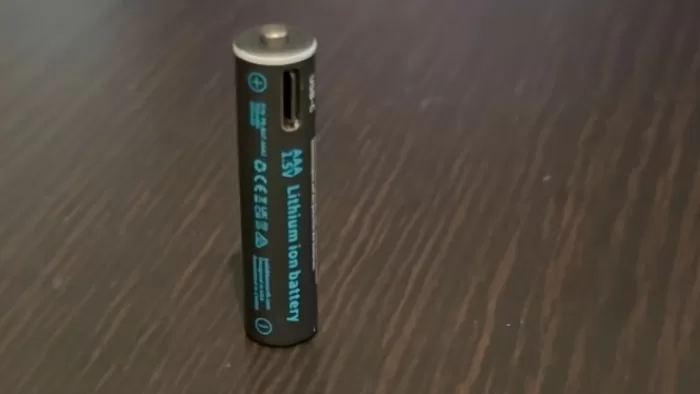
Paleblue’s rechargeable batteries are nicely made and could help save you both money and battery waste – but you really need to do a few sums when considering them.
| Pros | Cons |
|---|---|
| USB-C recharging is super handy | Comparatively expensive |
| Packaging is also a storage case | You’ll need a screwdriver to get into the packaging |
| 1,000 recharge cycles claimed | That might not equal replacing 1,000 batteries |
Score: 3/5
 |
Buy Paleblue Batteries! | Buy On Amazon |
Rechargeable batteries aren’t a new concept by any stretch of the imagination, but Paleblue’s pitch for them is just a little different to other rechargeables I’ve used in the past.
Most of these batteries tend to either come with their own custom charger, or only work with specific chargers, which means when the charger dies, it’s time to say goodbye to those batteries, or spend even more on a custom charger.
Paleblue’s batteries instead rely on standard USB-C charging, with a socket built into each battery. The claim is that they’re good for more than 1,000 recharge cycles, which the company claims means that they’re good to replace 1,000 (or more) single use batteries.
A bold, environmentally friendly claim – though I can’t help but think that you do need to do a little maths to work out if the sums really add up that way.
Design

Ordinarily, I wouldn’t have much to say about battery design, because they’re built to a standard form factor size – AA, AAA, that kind of style – to work across a wide array of power-hungry gadgets.
The Paleblue Batteries – I was sent a set of the AA and AAA variants – do have a couple of interesting design quirks, however, starting with the packaging. Again, I wouldn’t ordinarily mention the packaging on most products unless I was doing an unboxing video.
Unboxing the Paleblue Batteries can take some time, however. They’re built around a simple cardboard outer frame that’s trivial to remove, but then, rather than sitting in (horrible) blister style packaging as you get with many batteries, you’re instead faced with a clamshell case that’s screwed in place.
Heavily screwed in place with small metal screws that you’ll need a jeweller’s screwdriver to remove. That does make them rather wonderfully complaint with battery safety standards, not that Paleblue makes button style batteries as far as I can see. It also makes them rather tricky to get into for first use.
The idea here is that because they do attract a premium price, it makes sense to have somewhere safe to store them at all times, so rather than have throwaway plastic packaging, it’s rather more permanent, with space for all four batteries plus the multi-headed charging cable that’s used to power them all up.
Performance
The AA and AAA batteries that Paleblue sent me were fresh out of the box, and in that state they’re not fully charged – which means my first stop was a USB-A type charger.

The cable that ships with the Paleblue Batteries is USB-A at the primary end, and then four-headed with USB-C on the other ends. Each battery flashes up as it charges, turning solid green when fully powered up. It’s kind of like having battery-shaped Christmas lights if you’ve got them all charging at once.
Each Paleblue battery has a USB-C port on it; for the AA batteries it’s horizontal near the top of the positive terminal, while the smaller size of the AAA batteries means that they sit vertical instead.

There’s no actual charger in the box, but they’re clearly designed to plug into most standard/slightly older phone chargers primarily. While USB-C is a standard, I had mixed results using a variety of higher-power USB-C chargers.
Some would happily glow up, while others steadfastly refused to work at all. I also tested using a variety of power banks, which feels kind of ridiculous, given I was charging a battery with… a battery… but here I had no joy at all.
I could get individual batteries to charge from a standard 5V charger with a single point cable, though, so if you do lose or break the cable, you’re not totally out of luck.
Still, it would be nicer if they’d work consistently off higher capacity chargers. I’m not expecting them to charge faster, just to be able to take a charge that way.
What about actual battery life? This is always a super variable matter, because the power draw of a remote control is different to that of a torch or a portable games console or anything else that can take a standard battery.

I should pause here and note that it’s generally not advised to use rechargeable batteries in smoke detectors, though much of the advice here tends to talk around rechargeable NiMH batteries, not lithium ion as used in Paleblue’s batteries. There may be some issues around specific voltage requirements for smoke detectors that still apply however, so it’s a good idea to check the specifics for your smoke detector before going down the rechargeable route.
Across a bevy of gadgets, some low power usage, others high-power usage (I knew I kept those older portable consoles around for a reason!), I was generally happy with the Paleblue battery’s performance.
To give that some proper context, for one test I threw two of the AA batteries into an IPS LCD modded GameBoy Advance, which typically chews through regular cheap batteries due to the upgraded screen.

The Paleblue batteries gave more than four hours of runtime in one session, at which point I stopped more because my fingers were getting cramped than anything else. Again, it’s variable, depending on how you use them, but at least for brand new Paleblue batteries, the overall life is decent relative to their capacity.
That capacity is, however, the key reason why I warned about doing your sums carefully – and I’m not just talking about the purchase price of the batteries themselves.
Paleblue’s contention is that their batteries should be good for 1000+ recharges, and that as a result they’ll effectively “replace” 1,000 single use batteries or more, which should be an environmental win.
Properly used, rechargeables absolutely can reduce the environmental hit of battery usage, but for a lot of the batteries you’re likely to use, it’s not a straight 1:1 comparison.

The AA Paleblue batteries have a listed capacity of 1,700mAh, while the AAA batteries, being smaller, top out at 600mAh.
Battery capacity of standard AA or AAA batteries can vary a lot, and for sure if you’re buying super-cheap no-name batteries you might see that level of power.
But for higher-capacity batteries, you could well see much more than that capacity, at which point each recharge cycle of the Paleblue batteries doesn’t equate to one “used” single use battery at all. Over time, Lithium Ion batteries degrade, so you’d get less than this 1,700/600mAh capacity too, further skewing those results.
The other catch here – at least in a potential sense – is the way that the Paleblue batteries recharge. USB-C is quite handy, but it does mean that for each and every one of those 1,000 recharge cycles, you’re going to be pulling a cable in and out again to power it up.
Obviously I’ve not had the Paleblue batteries long enough to fully stress test them over 1,000 cycles, but I do wonder if they’ll actually last that long, because once the socket goes, even if the cells in the battery itself were fine, you’d be stuck with no way to recharge them.
Paleblue Batteries: Alex’s Verdict

I like what Paleblue is trying to do within the rechargeable space. There’s absolutely no doubt whatsoever that battery usage is a big environmental problem, especially if you don’t actively recycle batteries.
This is your reminder that battery recycling is damned easy to do in Australia, and you should do so for every battery you buy. Here’s a link to find the nearest battery recycling location near you, just in case you figure it’s too hard. It really isn’t.
That being said, not producing those batteries in the first place has an environmental cost too, both in power and chemical production, packaging, shipping and more. Using rechargeables mitigates much of that, though not 100%. It’s not like they magically spring to life with a sprinkle of fairy dust!
The Paleblue batteries work quite well for most household battery tasks, and the use of USB-C recharging does make it much simpler to power them back up again when they’ve gone flat.
However, I do have my doubts about the long term viability of that USB-C port, and the claim of “replacing” 1,000 single use batteries isn’t entirely mathematically sound, depending on the types of batteries you typically use.
Paleblue Batteries: Pricing and availability
Paleblue Batteries retail in Australia in a 4-pack of AA or AAA batteries at $49.95. That’s the same price you’ll pay for 9V or C type Paleblue batteries as well, though you only get 2 of those to a standard pack.
 |
Buy Paleblue Batteries! | Buy On Amazon |
Was this review useful to you? Support independent media by dropping a dollar or two in the tip jar below!





